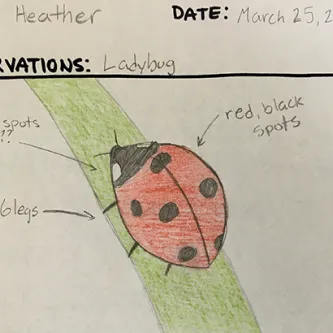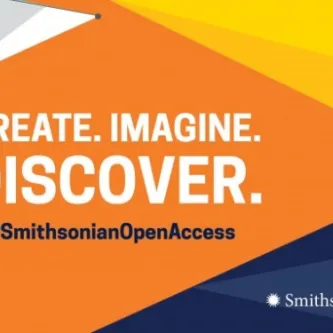Search
Digitizing Nature – Field Books to Fossils
Recording Our Observations of Nature
These days, we record our observations of things in the world with text and images using our cellphones, computers, and cameras. Many of us capture memories of what we’ve seen to reflect on later or share with friends through social media. Scientists doing field research can strap on a fist-sized video camera that captures the environments they encounter and their interactions with wildlife. We have a wealth of technology at our disposal to record and share information with others.
Early explorers did not have the luxury of quick communications. Tasked by Thomas Jefferson with documenting the natural assets of the young nation, Lewis and Clark sent hand-written journals back by riverboat and ocean vessel. Through drawings and text, their journals brought to life the plants and animals they found and collected. While not many of their specimens survived the ravages of time, the journals did. They provide a detailed snapshot of North American ecosystems along the route Lewis and Clark traveled more than 200 years ago.
Digitizing Field Books
The field records made by legions of explorers and naturalists over the years provide a look back in time at ecosystems we continue to study today. During her research in Central and South America, the Argentinian botanist Dr. Cleofé Calderón named 18 new species of grasses, and relocated a species of bamboo that hadn’t been seen in over 90 years. The Field Book Project at the Smithsonian is working to make Cleofe’s and other historic field records available digitally. Today’s botanists, such as Dr. Paul Peterson and Dr. Robert J. Soreng, can use her data to continue to study the distribution and evolution of grasses.
However, digitizing historic field books is no small task. Transcribing from handwriting to digital records is labor-intensive. One solution turns out to be “crowd-sourcing”--enlisting the help of many people via the internet. What may be an overwhelming task for one individual is a doable task for a group of online volunteers. The Smithsonian Transcription Center is a hub to crowd-source transcription of field journals and other records. When the Bumblebee Project invited people to transcribe the historic labels on bumblebee specimens, a squad of volunteers transcribed 3,198 labels, making the data accessible to scientists around the world.
Many field records from the 19th century were meticulous enough to reveal how ecosystems have changed over time. Former Collections Manager Rusty Russell used a set of more than 22,000 historic field records from southern California to analyze how ecosystems had responded to rapid urbanization. He led teams of young citizen scientists in resurveying historic field sites. Comparing the first to second half of the 20th century, he calcualted a 30 percent change in plant species composition; some species could not be found while others had invaded the area.
Digitizing Specimens
As former Collections Manager of the U.S. National Herbarium, Rusty Russell had more than 5 million plant specimens in his care. Yet, to make his observations about Southern California ecosystems also required plant records from other herbaria. As herbaria around the world rise to the challenge of sharing data outside of their walls, it again comes down to digitization.
At the National Museum of Natural History, long conveyor-belts fed plant specimens and records into an imaging machine. Even at a rapid digitization rate of about 4,000 specimens per day, it took seven years to digitize the whole collection. Museums are employing information specialists, such as Sylvia Orli, to speed them into the digital age.
Consider that museums are racing to digitize not only their plant specimen records, but also animals, rocks and minerals, human artifacts, and other collections. At nearly 25 million objects with electronic records to date, the Smithsonian is gradually working its way through all 138 million specimens and other objects in its care.
3-D Digitization
As digitization takes hold in museums, new tools emerge that make it an even more powerful way to capture information. Paleontologists such as Dr. Nick Pyenson have used 3-D technologies to digitize specimens in the field, where they are found, such as a graveyard of fossil marine mammals in the Atacama Desert of Chile. The dozens of fossil whales were discovered as Pan-American Highway construction crews exposed new ground. The whales appeared to have stranded as many as 9 million years ago, offering a unique window into a time when this part of the Atacama Desert was an ocean.
Unable to remove all the whales in the path of the construction, Nick and his Chilean colleagues prevailed on Smithsonian’s 3-D digitization team to quickly capture the digital data. Using laser-scanning technology and photogrammetry, they were able to record the shapes and positions of the bones in the ground. The 3-D models of the Atacama whales can now be shared with colleagues across the globe as they continue to study the evolution of marine mammals.
Smithsonian's X 3-D team is not only modeling whale bones, but also wooden masks, blue crabs, and even the Apollo 11 Command Module.
Natural History Unveiled
If we could travel back in time and show earlier naturalists how we are capturing data today, they would surely be amazed. Imagine how the Smithsonian's Frederick W. True, who in the late 19th century and early 20th century pioneered the collection of data from marine mammals stranded on beaches, would appreciate the 3-D scanning technology.
While digitization gives us a look into the past through the field records of historic naturalists and the bones of fossil whales, it also propels us into the future by offering new ways to capture, combine, and corroborate data across the globe.

